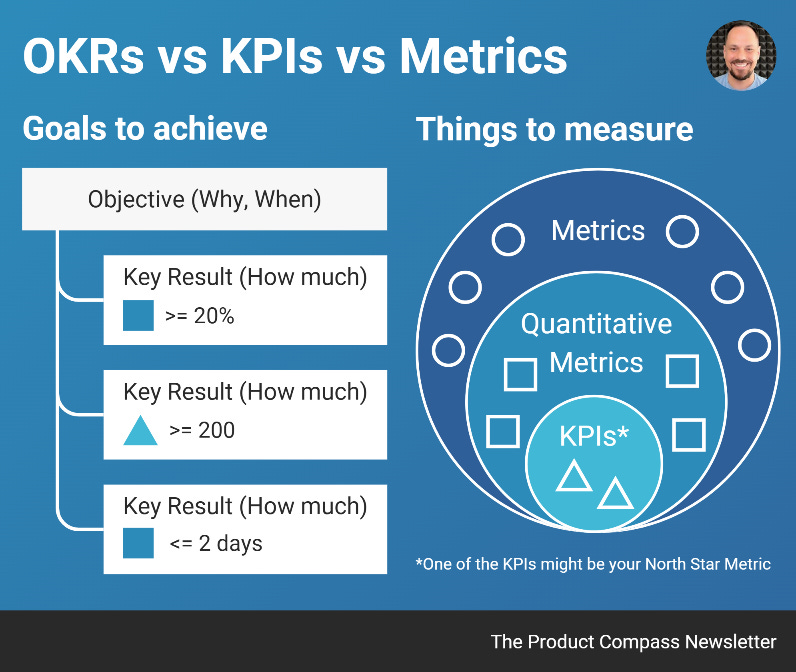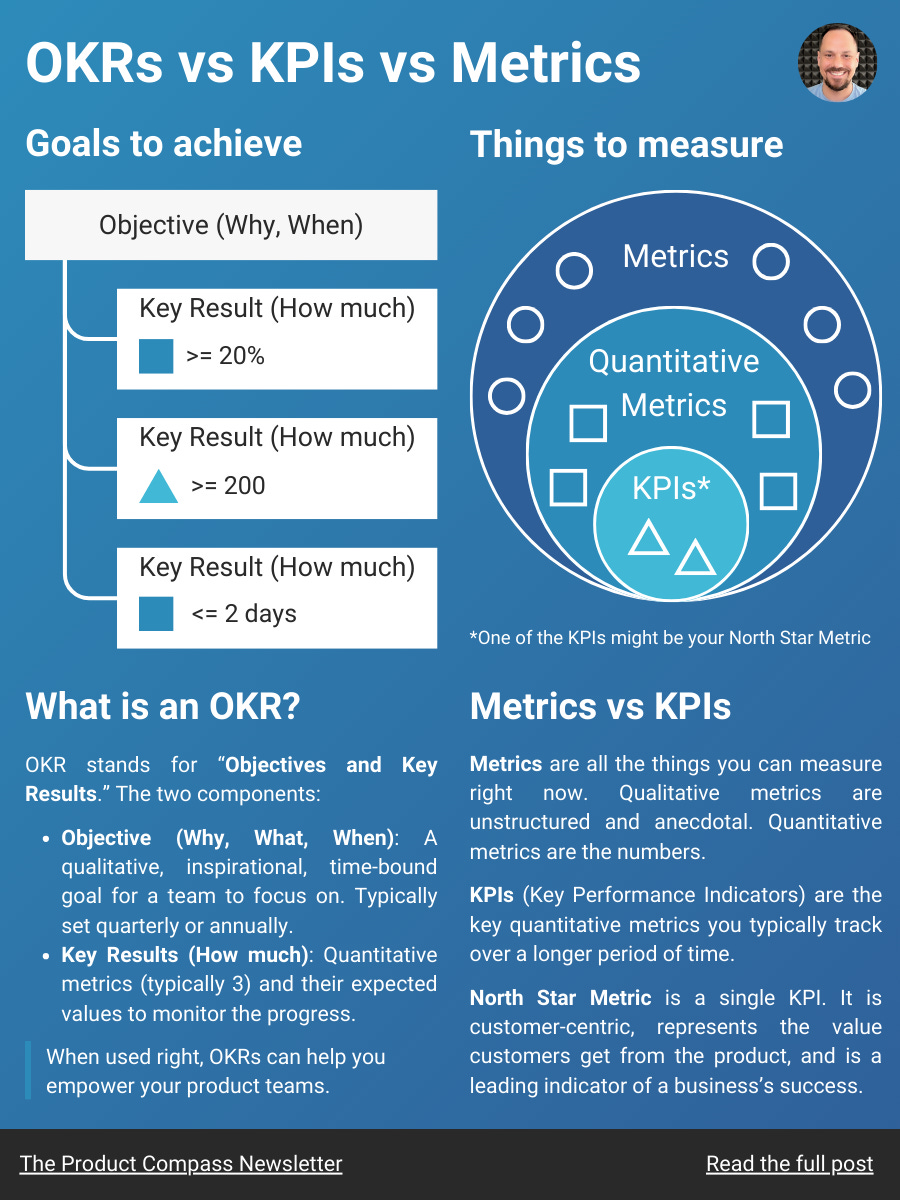OKR vs KPI: What's the Difference?
When comparing OKRs and KPIs, many forget a critical aspect - the relationships between them.
Hey, Paweł here. Welcome to the special edition of The Product Compass.
Every week, I share actionable tips and resources for PMs.
Consider subscribing and upgrading your account, if you haven’t already, for the full experience:
When comparing OKRs and KPIs, many forget a critical aspect - the relationships between them.
A picture is worth a thousand words:
In short, the Key Results in the OKR always refer to quantitative metrics, some of which might be KPIs. Comparing KPIs to OKRs in the form of a table without explaining their relationship doesn’t make much sense.
Let's dive into more details.
1. What are OKRs?
OKR stands for “Objectives and Key Results.” The two components:
Objective (Why, What, When): A qualitative, inspirational, time-bound goal for a team to focus on. Typically set quarterly. It should be SMART.
Key Results (How much): Quantitative metrics (typically 3) and their expected values to monitor the progress toward the objective.
Note: I have updated the questions to account for how readers prefer to memorize them.
An OKR Example:
Objective: Delight new users with the onboarding flow
Key results:
Customer Satisfaction (CSAT) >= 75%.
66%+ onboardings completed within two days.
An average Time to Value (TTV) <= 20 minutes.
OKRs are fundamentally about:
Setting a single, inspiring goal.
Empowering a team to determine the optimal approach to achieve it.
Continuously monitoring the progress, learning from failures, and improving.
For more information, see (freemium): Objectives and Key Results (OKRs) 101
2. KPIs vs. Metrics: What’s the difference?
What’s the difference between KPIs and Metrics?
What are metrics?
Metrics are all the things you can measure. In particular:
Qualitative metrics are unstructured and anecdotal.
Quantitative metrics are the numbers.
In the context of OKRs and Key Results, we always use quantitative metrics.
For more information about different types of metrics, see a free post: Are You Tracking the Right Metrics by
.What are KPIs?
KPIs (Key Performance Indicators) are a few key quantitative metrics a company focuses on and typically tracks over a longer period of time.
You can use them in your Key Results, use them as health metrics (a balancing practice for OKRs), or identify and set Key Results for one of the KPI’s input metrics.
North Star Metric vs. KPIs
North Star Metric is a single KPI. It is customer-centric, represents the value customers get from the product, and is a leading indicator of a business’s success.
For more information, see (freemium): The North Star Framework 101
3. BONUS: A high-res OKRs vs KPIs PDF to download
Find this useful?
Thanks for reading The Product Compass
I appreciate it!
Your comments, reactions, and private messages motivate me to keep going.
If you are not a subscriber, here are a few posts you might have missed:
Consider subscribing and upgrading your account, if you haven’t already, for the full experience:
Have a fantastic long weekend! 🙌
Take care, Paweł






Thanks for this post! It was helpful to see the differences laid out. I agree with Patrick that too in practice we can too easily ignore meaninfulness. The issue I see is that it's often hard to know how to measure what matters -- budget, time and even understanding the basics of measurement can all come into play. I have sometimes settled for "good enough" proxies, with low grade worry about diverting focus to what we care about. I welcome any thoughts on this quandry. Thanks!
I love how you call out that analyzing/explaining the relationship between OKRs and KPIs is critical.
It tackles a couple of my pet peeves with how people implement them.
1. They ignore “meaningfulness”. OKRs and KPIs are only valuable if they measure something meaningful to what you want to achieve and in a meaningful way. Too often people just pick what they can easily measure and optimize around it. Why should e-book downloads matter to our efforts? Does the metric actually prove what we need it to?
2. They treat it as a performative act, used to justify decisions vs. guiding them. i.e. I already know what I want to do and I’m going to build my OKRs and KPIs to support that.
Having to regularly analyze and explain the relationship between your OKRs and KPIs would help force you to address the above.